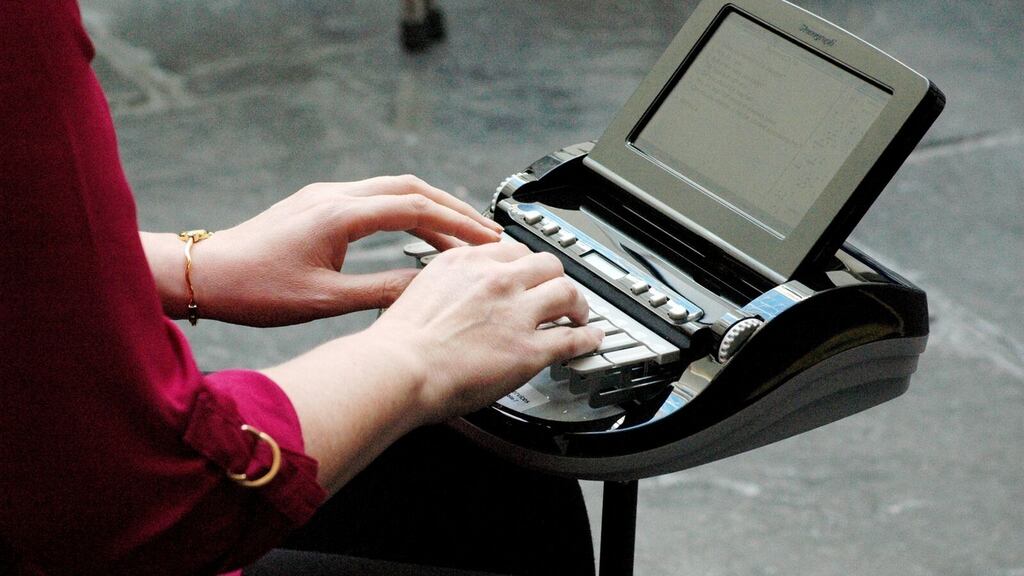"A stenographer is meant to be seen and not heard, like a young lady," says Gwen Malone, very much tongue-in-cheek.
The head of Gwen Malone Stenography Services, she is right about the invisibility of stenographers; they are rarely noticed in the courts, tribunals, arbitration and extradition hearings where they work, yet they often play a vital part in ensuring those hearings run smoothly. A stenographer's job is to record every word that is said. It is intense work done on a stenograph. The machines don't use the standard keyboard of a typewriter, instead they work by phonetics and have only 22 keys.
In the company's office on Bow Street, not far from the Four Courts, in Dublin, Trish Myler, who works for Malone, tries to explain how the system works.
Each key can be a word, a combination of keys can be a different word, she says. Words are recorded syllable by syllable. She demonstrates the key strokes on her machine. The strokes produce text in the language of the stenograph, which is translated into English using computer software. She repeats the actions, and tries to explain what each key can mean. It is difficult to grasp and that’s not surprising. It takes two years in college to learn stenography and then two years to train on the job.
“It is one thing having the skill, but it’s the training of the ear that counts; your ear has to be very finely tuned,” says Malone.
“We wouldn’t dream of sending anyone straight out of college into a hearing on their own. They are spoon-fed to get them up to standard and that could take two or three years.”
When stenographers qualify, they can transcribe 220 words a minute; with experience, they can get that up to 250 or 260, she says.
Many students don't stick the course, however. Myler, who studied in 1996, was in a class of 12. Only four of those students graduated and she is the only one of them still working in the business in Ireland.
Stenographers need to develop the ability to have a blank mind, she says, to focus on the present and hear the words coming in. They are constantly learning new jargon. Barristers, who read documents into the record sometimes at speeds of 320 words a minute, are a particular challenge.
“I listen to each word; so there are times when the court has burst out laughing and I haven’t known what the joke is,” Myler says.
Discretion, too, is an essential skill, according to Malone.
“They filter and get the words down, they don’t carry the weight of it with them,” she says. They may be dealing with “delicate matters”; they are trusted by clients to be discreet.
“Nobody talks about a case they’re doing, even if it is in open court, you’re talking about people’s lives,” she says.
When Malone began her business in the early 1990s, the machines had paper coming from them like “a busman’s ticket” with the information contained on it. As technology developed, floppy discs were used. Now the machines take a secure digital card, much like a camera’s memory card. It can be placed directly into a computer and the data is translated into English. Once that’s done, the stenographer checks the transcript, correcting spellings and punctuation. If in any doubt, they may also listen back to the audio to check that nothing has been missed.
“If two or three people are speaking at the same time, you can only listen to one; I go with the loudest, then I have to listen back to get what the others have said,” says Myler.
The clean transcript can be with a client by 7.30pm on the day of a hearing.
Technology also allows the stenographer to live-stream text as it is typed, so a barrister, solicitor or experts outside the court or in another country can read and analyse what is being said instantly.
Do stenographers make mistakes?
“They do have the luxury of time to go through a transcript . . . so in theory they can be 100 per cent accurate, but we are humans, so 99 per cent,” Malone says.
She loves new technology and is constantly updating equipment, imported from the US. But she is not so enamoured with the digital audio recording (DAR) system introduced in courts in Ireland over the last 10 years.
The system effectively did away with the use of stenographers in criminal trials and, when a stenographer is employed for a court case now, it is because one or other of the parties has agreed to pay for the service, or a judge has specifically requested it. Costs vary depending on turn-around time and other factors, but may be in the region of €1,000 to €1,400 a day.
Malone says the DAR is simply an “aide memoir” for the judge and can’t be compared to a transcript in the hand. “Last Christmas Eve I got a phone call, saying ‘the president [of the High Court] wants to know can you cover a hearing in emergency sitting’,” Malone says. “We covered it Christmas Eve and St Stephen’s Day. The DAR was no good to them, it had to be instant.”
She said while digital devices have their merits, most judges realise the value of a stenographer in court and appreciate their work. “There is nothing like a stenographer.”








